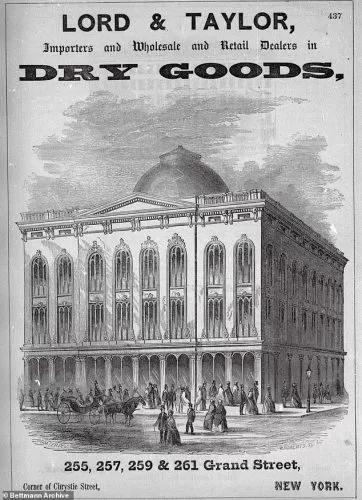America’s Oldest Department Store
The title of America’s oldest department store typically goes to Lord & Taylor, which was founded in 1826 in New York City.
Originally a dry goods store, it grew over the years into a full-fledged department store. Lord & Taylor is renowned for its long history and was one of the first to introduce the concept of a department store to the American shopping experience.
However, if you’re referring to the oldest department store still operating under its original name and concept, Lord & Taylor has largely been out of operation since its parent company filed for bankruptcy, and many of its locations have closed or been sold.
As of now, Macy’s (founded in 1858) is one of the most recognizable department store chains still in business and operating across the U.S., particularly known for its flagship store in Herald Square, New York City.
Following a challenging 2020, marked by Kobe Bryant’s tragic death, the COVID-19 pandemic, and civil unrest, traditional retailers struggled.
Lord & Taylor, America’s oldest department store, couldn’t survive the economic hit and is now closing all 38 stores.

Acquired by the French company Le Tote Inc. in 2019, Lord & Taylor filed for Chapter 11 bankruptcy due to mounting financial pressures, initially planning to keep 14 locations open.
Founded in 1824 as the first U.S. department store, the brand’s decline accelerated after selling its Fifth Avenue flagship to WeWork (later acquired by Amazon).
Lord & Taylor holds the distinction of being the oldest department store in the United States. It began as a dry goods store at 8 Wall Street in New York City. The founders expanded the business over the years, offering more variety of goods, and it became known for its upscale offerings. Lord & Taylor is famous for its elegant, high-end clothing, including designer fashion, as well as fine home goods.
In the 1910s, the company became known for its innovative marketing and retail practices, such as creating elaborate window displays during the holiday season. It also gained a reputation for its customer service, and the store’s flagship location on Fifth Avenue became an iconic symbol of luxury shopping.
However, despite its long and storied history, Lord & Taylor faced difficulties in the 21st century, leading to a series of ownership changes. In 2020, Lord & Taylor filed for bankruptcy and closed many of its locations, including the iconic Fifth Avenue flagship store. The Lord & Taylor brand, which had been acquired by the Hudson’s Bay Company, was eventually sold to a new owner, and much of the business has been moved online.
2. Macy’s
Founded: 1858
Founder: Rowland Hussey Macy
Location: New York City
Macy’s is another landmark in American retail, although it didn’t beat Lord & Taylor in age, it is often considered the most iconic and widely recognized department store in the U.S. Macy’s history began in 1858 when Rowland Macy opened his store in New York City. His store was unique for its use of large, visible signage and for creating a customer-friendly environment. Macy’s also introduced several innovations, including the first department store Santa Claus, and it became known for its elaborate holiday parades, such as the Macy’s Thanksgiving Day Parade, which began in 1924.
The company’s flagship store, located at Herald Square in Manhattan, is still one of the largest department stores in the world and attracts millions of visitors each year. Macy’s has played a major role in defining the department store experience, from the grand, ornate interiors to its extensive selection of merchandise, from clothing and beauty products to home goods.
Despite challenges faced by traditional retail in the internet age, Macy’s continues to thrive, though it has been shifting more towards an omnichannel business model, blending physical retail with e-commerce. Macy’s also operates the Bloomingdale’s brand, which is known for higher-end fashion and luxury items.
3. Saks Fifth Avenue
Founded: 1924
Founders: Horace Saks and Bernard Gimbel
Location: New York City
While not as old as Lord & Taylor or Macy’s, Saks Fifth Avenue is another iconic name in luxury retail. It began in 1924 with a flagship store at 611 Fifth Avenue in New York, which remains one of the most prestigious shopping addresses in the world. Saks quickly became synonymous with high-end fashion, luxury items, and top-tier customer service.
Saks was one of the first department stores to introduce designer boutiques within its walls, and it helped shape the fashion landscape by bringing high-fashion brands to the masses. In addition to its role in retail, Saks also became known for its stunning holiday window displays and its upscale restaurant, which was a key part of the New York shopping experience for decades.
Today, Saks Fifth Avenue is owned by Saks Fifth Avenue Enterprises, which operates both a physical store network and a strong e-commerce presence, having also branched out into online luxury fashion retail with Saks.com.
4. JCPenney
Founded: 1902
Founder: James Cash Penney
Location: Kemmerer, Wyoming
JCPenney (sometimes stylized as J.C. Penney) was founded by James Cash Penney in 1902. It began as a single store in Wyoming and expanded rapidly in the early 20th century to become one of America’s largest department store chains. JCPenney is known for its wide range of affordable products, from clothing to home goods, and it became a mainstay in many American shopping malls.
For many decades, JCPenney epitomized the American department store experience, offering reliable, reasonably priced merchandise for middle-class families. Over the years, it faced increased competition from both discount retailers and online shopping, which led to financial difficulties in the 21st century. However, the company continues to operate both physical stores and an online business.
5. Kaufmann’s
Founded: 1871
Founders: Morris Kaufmann
Location: Pittsburgh, Pennsylvania
Kaufmann’s was a beloved department store based in Pittsburgh, founded in 1871. It was known for its regional dominance in Western Pennsylvania and had a reputation for carrying high-quality merchandise. Kaufmann’s became a Pittsburgh institution and was particularly famous for its elegant store designs and extravagant holiday displays.
In 2006, Kaufmann’s was acquired by Macy’s, and the Kaufmann’s name was eventually phased out. Today, Macy’s operates in the former Kaufmann’s locations, but the Kaufmann’s legacy is still fondly remembered by many in Pittsburgh and the surrounding region.


